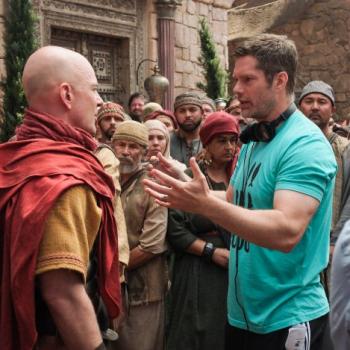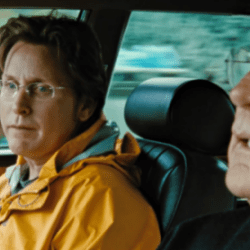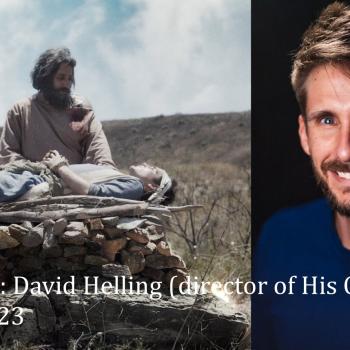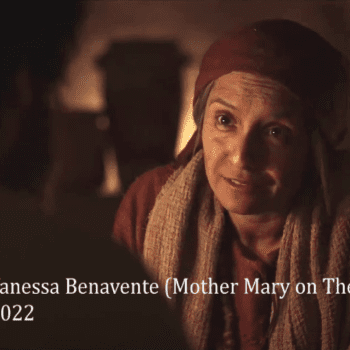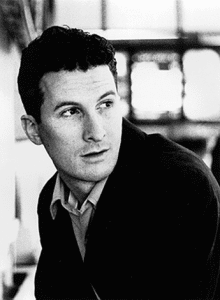 Darren Aronofsky shot his brilliant debut feature film Pi for a paltry U.S. $60,000, a sum he raised partly by asking everyone he knew to give him $100 in exchange for a place in the film’s credits.
Darren Aronofsky shot his brilliant debut feature film Pi for a paltry U.S. $60,000, a sum he raised partly by asking everyone he knew to give him $100 in exchange for a place in the film’s credits.
The film concerns a brainy mathematician named Max who is convinced that there is a pattern — perhaps of divine origin — underlying the apparently chaotic universe. Wall Street brokers and Kabbalistic Jews agree, and they want to use the secrets locked inside Max’s brain.
Inventive imagery, creative montage and, above all, some truly interesting ideas raise this film above the more pedestrian flicks that fall under the “independent film” umbrella these days. Aronofsky discussed some of those ideas with Two Chairs during a phone interview shortly before his film opened at the Fifth Avenue theatre.
PTC: How did you get the idea for the film? Where is it from?
DA: It’s sort of a scrapbook of experiences I’ve had, stories I’ve heard, things I’ve read. I sort of had a deck full of stuff and shuffled them and out came Pi.
PTC: Have you studied mathematics yourself?
DA: Not really. I studied mathematics in high school, stopped doing mathematics when I was a junior. You know, the film’s not really about math. It’s more about mystical math. It’s about using numbers [when] searching for God. Those ideas really intrigued me.
PTC: Have you got any sort of religious background?
DA: Not really. I just thought the Kabbala was very interesting stuff when I experienced it, and I learned some of it when I was in Israel, visiting, and I just found it intriguing. All the Kabbala stuff in the movie, by the way, is completely true. A lot of people think I made that stuff up, but it’s really one hundred percent true. People live by that and die by that stuff.
PTC: Well, I’ve taken a couple of courses on Jewish literature, and the Kabbala has come up in there before —
DA: Oh, cool.
PTC: — and the fact that letters count as numbers and so forth. I notice that your website for Pi has a link to an article on the “Bible code”. Do you see that as a nice sort of coincidence?
DA: It’s so strange, the synchronicity of pop culture is always happening to me. When we were almost finished cutting Pi, I heard about Bible codes, and three weeks later I hear that Madonna is doing Kabbala, and it’s very strange how people are all sort of interested in the same thing as the same time.
PTC: What about yourself? Do you put much stock in that sort of thing?
DA: Into Kabbala?
PTC: That, yeah, or Bible codes.
DA: I find it very intriguing, and when I was doing research for the film, I saw stuff that really, really blew my mind, stuff that I just couldn’t explain, and it was very interesting.
PTC: Oh-kay. Anything more specific than that?
DA: Y’know, I could, but it’s about a 45-minute discussion. I need paper and pen. But I saw stuff, these sort of big mystics, or these sort of Jewish shamans, that go around and perform small miracles.
PTC: Interesting. Performing small miracles with numbers and stuff, or something more empirical?
DA: Something more.
PTC: Okay. One of the things I wasn’t quite sure about while watching the film — and this may be one of those things you want people to discuss — was the question of whether there actually is a pattern or if it’s simply a matter of somebody perceiving a pattern. How much of that pattern is actually there, and how much of it is people just thinking they see one?
DA: Well, that’s exactly the big question of the film. That’s what we want people walking away with, discussing. The best part is when audience members actually start looking for patterns within the movie, which there are some.
PTC: Intentional?
DA: Oh yeah, that’s always great, when people respond to those.
PTC: How much of those patterns was intentional and how much was accidental?
DA: Some people come up with theories about Pi that are way out there! (laughter) That I had no clue what was going on. Some things, y’know, like, the whole structure is constructed like a puzzle. There’s repeating themes and repeating locations and repeating thoughts.
PTC: Emulating the spiral pattern, coming back to things?
DA: Some of the structural things we did do relate back to the spirals and also to the Fibonacci sequence. For instance, we even shot the film in a ratio called 1.68 which is rarely ever shot. It’s shot sometimes in Europe, but it’s never really shot in America, and the reason we shot that is because that’s the Golden Ratio.
PTC: I was wondering about that.
DA: It’s a very strange shape, the screen. I mean, most 16mm films are usually 1.33, which is a TV set, and most feature Hollywood films are 1.85, and we shot it somewhere in the middle. The Golden Ratio supposedly, theoretically, has this well-balanced form, which intrigued me, and that’s why I shot it in that ratio, because, y’know, Pythagoras discovered this, and DaVinci and all the scholars in the 17th century started to pencil it into all their paintings, and now it’s followed through so that credit cards are actually 1.68 ratio, which is kind of weird.
PTC: Would you say that you yourself see a pattern in the world, and if there is a pattern in the world, does that necessarily indicate anything beyond?
DA: Well, think about it. It’s kind of weird that our DNA and the Milky Way are both the same shape, that the smallest building block of our bodies and the largest shape of our home are the same shape. That’s just a little too strange. And, y’know, the circle’s another repeating pattern you see everywhere. You see it in your lover’s eyeballs and the sun, the moon, and it’s just kind of strange that there are these repeating patterns everywhere.
PTC: Yeah, okay, they’re there, but can one go beyond that, though?
DA: And say what?
PTC: Either that there is a purpose or a God apart from that?
DA: Well, I’m not sure if the spiral is the pattern that represents God or the circle is, but it definitely makes you wonder why that is. There clearly is an order beneath the chaos, and it’s a matter of wondering what that order is. Is the ultimate order God? I don’t know, that’s a hard one to answer. (laughter) People have been asking that question since the beginning of time, but, y’know, maybe.
PTC: Are you familiar with Contact — the novel, not the film?
DA: I actually have never read the book, but I did see the movie.
PTC: Have you heard about the role that pi plays in the book?
DA: I heard that that’s the actual first message that they beam to us or something.
PTC: I think they start with prime numbers, actually, and that’s how we know that we’re getting an intelligently coded message, but in the last pages, if I can spoil the ending —
DA: No, that’s fine.
PTC: — in the book, the Jodie Foster character discovers a message coded in pi. Somewhere down the string of digits, she discovers a long sequence of zeroes, and then a sequence of prime numbers, and because it’s a transcendent number, this sequence of digits must be a coded message from God, is the idea.
DA: Wow.
PTC: And I was just wondering if you were familiar with that at all.
DA: No, that’s great, that’s exactly what intrigued us about the number. You have this very simple shape, a circle, and then you take the circumference and divide it by the number — a very, very simple operation — but then suddenly you have this immense complexity, you have the number 3.14 that stretches off into infinity, and the question is, What is in that infinite string of numbers? Is the name of God there? Is it the universe’s DNA?
PTC: But another question that occurs to me — and I’m wondering what you’d make of this — is, if there is an infinite string of numbers, you know the old saying that if you get an infinite number of monkeys on an infinite number of typewriters eventually one of them will produce the works of Shakespeare?
DA: Oh yeah, and you don’t even need an infinite. All you need is one monkey for infinity sitting in front of a typewriter and all literature is there.
PTC: Right, so if you have this long, infinite sequence of numbers, can you really say that you find it? ’cause there is the one professor in your film who’s trying to find a pattern in pi, and if you have an infinite number of numbers, can you really say you have a pattern when, really, you should maybe expect to find everything?
DA: Well, maybe you could get closer — maybe you don’t need every single digit to find the pattern. Maybe the pattern is repeating and you only need a certain amount of numbers to actually get to that repeating pattern, or maybe actually it’s approaching what the pattern is, and maybe it’s the human aspect of our souls that takes the final leap from the numbers to the full understanding of the order.
PTC: (laughter) Okay.
DA: Did that make any sense? A little? Maybe.
PTC: It sounded like you were trying to transcend the transcendent number there, but okay.
DA: Well, I think once you do get the transcendent number, you do transcend. That’s my point, that, basically, the question of why are we here, once it’s answered, the question no longer exists.
PTC: Oh, interesting.
DA: It’s true, though. That’s what Max is all about. That’s what the white void scene is about.
PTC: You mentioned that all the Kabbala stuff was true. Does that include the idea that the true name of God is 216 letters long?
DA: That’s true. You wanna hear something weird, though, about that? Where it comes from is there are 72 three-letter names of God, and I was talking to a Hindu scholar about this, and he was like, “That’s weird,” because in Hindu numerology, you add the numbers up, so 216 would be 6 plus 1 plus 2 which equals 9, right? And he said 9 is the number of the apocalypse. And I said, “Oh, that’s interesting.” And I told him about 72 times 3, and he said 7 plus 2 is 9, and I said, “Hmmm, that’s interesting.” Then, later, I’m talking to another friend who is a neuroscientist, and he’s like, “Y’know, I never realized where you got the 216 number from.” And I said, “Oh, it’s from the Kabbala.” And he’s like, “Oh, did you realize it’s also 6 times 6 times 6.” It’s a little weird, right? No? You don’t buy it? Okay, hold on, I got one more for you. I just read this somewhere. Someone at Artisan figured this out. It says “Pi: Did You Know?” and it’s all these different things, like Albert Einstein was born on the day of pi, which is the first seven numbers of pi, March 14 1879 — it’s true, though. Anyway, the next thing is, the first 144 digits of pi — now I don’t know if you remember, but 144 was a significant number we brought up in Pi, it’s actually a Fibonacci number, it was the one that meant the Garden of Eden — and I didn’t write this, they put this together at Artisan and I just read it today — it says the first 144 digits of pi add up to 666.
PTC: No way.
DA: Yes, it’s right in front of me. And then it says, “Of course, 144 equals 6 plus 6 times 6 plus 6 — 12 times 12.” Kinda weird. But the weird thing is I didn’t even know that. That tripped me out. It just shows you you can find meaning anywhere, and I’m not saying that necessarily this meaning is in pi, but it goes to that whole speech that Sol says, that as soon as you go looking for order, you can find it anywhere. So I don’t know, maybe we’re all insane or we’ll all on the brink of discovering what God is.
PTC: Looking at your diary on the website, you said one of your rules for writing was, “No breaks for confusion — type through it.” And I was wondering if there might be a sense of that, just spew whatever comes out of your fingertips and then look for order perhaps within that chaos.
DA: (laughter) That’s interesting. Yeah, what I find is, more about the writing process, though, is like — I dunno, you’re a writer, so you must know that at times when you feel frustrated and you can’t write, but that if you actually just work through it sometimes great things come out from that, y’know?
PTC: Sometimes.
DA: Sometimes, yeah, I know, but sometimes not. But I just find, keep digging away.
PTC: You say there have been some way-out-there theories. What’s your favorite totally-unexpected theory about what Pi was all about, that you’ve heard?
DA: I’ve heard one that the original height of the main pyramid at Giza, if you take the original height before erosion and divide it by the base, you get pi. And why it’s significantly interesting is because the ancient Egyptians were at about 3.12. And people have used that to argue that we have been visited by aliens. (hums Twilight Show motif) I don’t think the aliens — I have no problem with aliens, I just have a problem with them being personified. It just seems so strange that these humanoid creatures would come down and build structures for humans. I buy more that — I don’t know if you remember Liquid Sky, it was a New York movie in the ’80s?
PTC: No, I haven’t seen that.
DA: Anyway, the aliens were these energy forces flying in a spaceship the size of a frisbee, and I was like, “That’s more interesting!” Because that’s probably what they would be, something totally different than what we think they are.
PTC: How about the making of the film itself? How much did it cost to actually make the film?
DA: $60,000 U.S., which is, what, ten million dollars Canadian?
PTC: Be nice!
DA: I’m joking!
PTC: And I hear that you made it on the sly, shooting without permits and so on.
DA: Oh yeah. The whole movie was a cyberpunk film. We tried to make the first cyberpunk movie in America — actually, I should say the United States, ’cause I guess Cronenberg did it in Canada way before anyone — but we tried to do that in New York City, and the whole attitude was, we are going to make this movie by any means necessary, so we did a lot of guerrilla filmmaking.
PTC: Were you ever caught?
DA: Uh, there was one time when a cop gave us a little hassle, but, y’know, Giuliani’s cops, you give ’em five bucks and they walk away. (laughter) But no, we didn’t really have any problems. We were very smart about avoiding police.
PTC: And they never asked you why you had brains on the staircase and everything?
DA: Actually, I was gonna not tell you that story, ’cause it was a long story, but I’ll tell it to you ’cause it actually happened. What happened is, we were shooting that sequence with the brains on the steps in a subway in Brooklyn, and there was blood everywhere, and every time a train would pull in, we’d have to stop production and cover the brain and ask people to watch out for the blood, y’know? And we had lookouts and everything, and we really tried to be on the tip, being hiding out. And finally I’m off thinking about a shot, and my first A.D. Laura comes up to me, she’s like, “Darren, how many stops to Coney Island?” And I’m like, “Laura, we’re not going to Coney Island until tomorrow.” And she’s like, “No, how many more stops to Coney Island?” And she’s pointing, and it’s a cop, New York City’s finest, staring at the brain, and I’m like, “Fuck!” The cop just nods and walks away, and I’m like, “Goddamn! New York City’s finest is so great, so awesome!” Anyway, we keep filming, we finish the scene, and we go back upstairs, and my producer Eric Watson is sitting in the van, and I tell Eric the story, and it turns out that Woody Allen is shooting across the street in Prospect Park, and she must’ve thought we were the second unit for him. So thank you, Woody Allen.
— A version of this interview first appeared in Two Chairs magazine.



